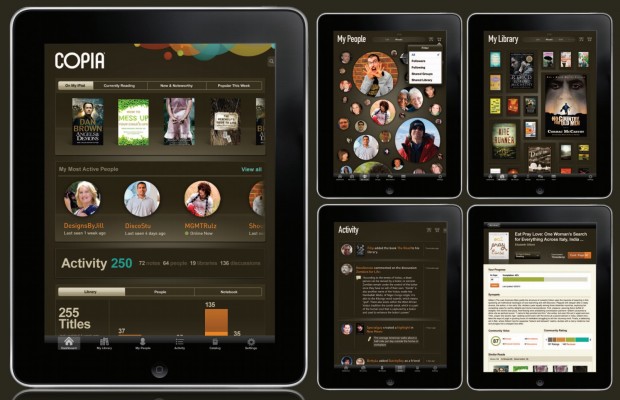Social Reading: Hey, did you know…

I know I’m not the only one who yet to adopt an eReader. I accept the fact that there are more and more cool devices out there for reading, from Kindle to Nook to Sony Reader to the latest, Kobo. Then there’s a host of social reading platforms, from the Washington Post Social Reader (a free Facebook application that offers a new way to read news — with your friends) to The Guardian‘s Facebook app (which by Dec 2011 was installed by more than 4 million users and drove up daily page impressions by almost 1 million). Google even joined in the fun with Google Currents.

What drives this latest craze? Is it because people like book clubs so much? Let’s define “social reading” first (or L.A. Times more appropriately asked “What the heck is ‘social reading’?”):
Look ahead: The presents have been opened, wrapping thrown away, and for a few quiet hours you’ve been curled up reading the new Steve Jobs biography, a gift from your dad. You find a surprising detail and call to your significant other, “Honey, did you know …?” but because he is busy making dinner, the idea fizzles away as you turn the page.
Or maybe when you get to that passage, with the swipe of a finger you highlight it and email it to your dad, adding a thanks for his gift. Or you click to add your thoughts to a chorus of readers who found that same passage interesting; or you check to see if there’s a link to a video clip; or you find an annotation from the author; or you post it to Twitter or Facebook or Google+, where others can comment on it too.
That’s called “social reading,” and it’s coming to an e-reading app or device near you.1
It’s not hard to believe that people want to share what they have read with other people and receive feedback about their thoughts and ideas. Technology is the great enabler for social reading, and the natural place for this activity to cultivate.2 I get it when it comes to news such as the case with Washington Post, The Telegraph and NY Times’ Recommendations. It’s discussion on current events, policies and the market. And it’s “happening right now.” But I guess there’s a need to opine on everything, even when it comes to chick lits, just like in a traditional book club.
Let’s take a look at one of the latest “club”: Copia, which bills itself as a Social Network for Book Lovers. It’s a social media and content delivery platform that brings together content, community and commerce to create an environment where users collaborate, socialize and buy content. Copia is accessible across a broad array of digital devices and platforms including Mac, PC, Android, notebooks, netbooks, iPads, slates, smart phones and eReaders.
With a tagline of “Reading reimagined for the iPad™” Copia wants book lovers to love it (because every book lover apparently has an iPad. Well, except me). It combines everything you love about the iPad with the most advanced social reading experience. Essentially, apps are increasingly being developed to enable users to electronically share thoughts.
Putting my reservations aside, Copia seems to offer lots of nice doodads like featured/most active groups, creation of notes, combining e-commerce & social. In addition to syncing your spot in a book, taking notes and highlighting excerpts, Copia lets you connect with other users. You can view notes that friends have made in the margins of a book, or join Copia Groups (essentially e-book clubs) and share recommendations. Copia has many of its own social networking features, but it also can connect with Facebook, Twitter and LinkedIn.3
I like to note that there are some bright and useful elements in these eReaders & social reading platforms, especially from Kobo and Copia, for UI designers and app developers to consider in a community /application design. It’s definitely a lot more user-friendly if used for eBooks but nice UI for the iPad & Desktop Reader.
Before I end this thought, I’m adding self-publishing factor into the mix. There are many out there as well but I like BookBaby, which throws open the doors to the electronic publishing and distribution world for independent authors, offering affordable short-run book printing with the highest pay-out rate for eBook distribution in the industry.


Now that makes it real interesting: BookBaby not only publishes for Kindle, Nook, Kobo and Copia (and distributed by the latest two partners), authors can also create custom-printed version of your book, with your own design! Bookbaby Print utilizes the latest layout and bindery technology, along with the highest quality paper, bindery stock and printing processes to produce books that are guaranteed to delight authors and their readers. Yes, don’t throw this baby out with the bath water!
So does this mean “gone are the days of “selfish,” private reading: reading alone in the bathtub, alone under the covers, alone on the couch, alone in the park, etc.”4? It’s still hard for me to swallow that idea, that reading doesn’t have to be a solitary activity. I really like my analog paper.
p.s. A look at using social reading for education. It’s in the form of collective reading that characterizes early reading instruction, where reading begins as a social experience. Now that’s something I can stand behind!
_________________________
1L.A. Times: What the heck is ‘social reading’?
2,4Tame The Web: Allison Mennella – What is “Social Reading” and why should Libraries care?
3Switched: Copia, A Social E-Reading App, Quietly Launches
